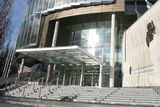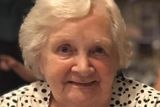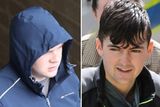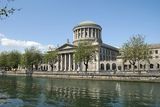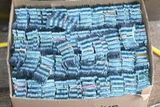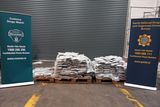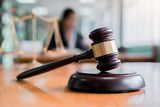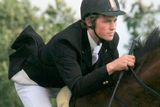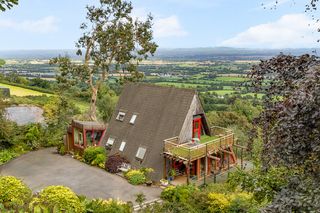The day Nixon came to Timahoe
On a cold, damp October 5, 1970, in a muddy field in Co Kildare, the most powerful man in the world stood on the humble remains of the homeplace of his ancestors. Irish Independent Managing Editor Michael Denieffe covered the visit and recalls that not everything went to plan
Hodgestown, Timahoe, just a few miles from Naas, was elevated from rural obscurity to international attention for a surreal three-quarters of an hour as Richard Milhous Nixon, 37th president of the United States -- and arguably its most controversial -- embraced his roots with awkward enthusiasm.
Nixon, of Quaker stock, was an unlikely candidate to be a triumphant presidential descendant of emigrants from Catholic Ireland. His visit with his wife, Pat, herself descended from Tipperary people, is mostly forgotten due to being sandwiched between the earlier adulatory visit of John F Kennedy in 1963 and the later, more popular, visits of Ronald Reagan and Bill Clinton.
Behind the rhetorical soundbites and green kitsch dripping around the visit, the Nixon version of 'American president comes home' had ulterior motives.
Nixon was eyeing up the huge Irish-American vote for impending congressional elections and his own bid for re-election to the White House in 1972.
He had gravely underestimated the Irish factor in his loss to John F Kennedy in the 1960 presidential election. He also wanted to use the visit to bolster his desperate efforts to extricate the United States from the calamitous Vietnam War, which was exacting a huge toll in casualties, resources and credibility.
Accompanying Nixon was his national security adviser Henry Kissinger and his chief-of-staff Bob Haldeman, who later figured in the Watergate scandal.
The visit also finally settled an outstanding quarrel. Which Timahoe was it? Timahoe, Co Laois or Timahoe, Co Kildare? As early as 1953, Nixon had mentioned casually that his ancestors had come from Timahoe. A search ensued with the Lilywhites scoring over their footballing rivals and declaring that Nixon's ancestors had emigrated in 1729 from the Quaker settlement in Timahoe, Co Kildare.
By 1957, relatives of Nixon had visited Timahoe and established the family connection. But Nixon was outmanoeuvred by Kennedy in playing the Irish card three years later.
Ultimate confirmation of the Timahoe connection was provided by the then 98-year-old Tom Cummins of Staplestown, Donadea, Co Kildare, who guided visitors to the site of the old meeting house near the Quaker burial ground. As the controversy raged, Tom recalled jumping from an oak tree on to a memorial slab 90 years previously and sure enough, the remains of the slab were found under the tree.
Nixon, who regularly belied his image as an austere, aloof career politician, spoke warmly to the old man and sent him a personal card for his birthday the following December. Olive Goodbody, historian for the Society of Friends in Ireland, presented Nixon with a copy of the certificate given to Thomas Milhous and his wife, Sarah Mickle, to introduce them to the Quakers of Pennsylvania. Most of the Irish Quakers stayed away, however, as a protest against Nixon's handling of the Vietnam War.
Kildare County Council had cleaned up the site, cut the hedges and laid down a gravel path for the visitors to negotiate the mud. A giant aerial on a nearby hill transmitted the proceedings to the world, while local media made do with public telephones helpfully mounted on wooden boards in the field by the Posts and Telegraph.
Secret service agents, who appeared to share the same tailor, stopped talking into their sleeves to shout at gardai to keep the 500 enthusiastic flag-waving bystanders well back. Nixon spoke of his pride to be standing on the spot from where Thomas and Sarah emigrated just before the American revolution.
Two hundred journalists collectively noted how Nixon's voice wavered as he reflected on his forebears. The Artane Boys Band, resplendent in bright new blue uniforms, struck up 'God Bless America' and the president called for a big hand for the band. Comic relief was provided when an impeccably dressed American journalist fell from the media platform into the Timahoe mud.
Quakers of Timahoe
Nixon then unveiled a stone monument to sustained applause. It read: "In memory of the Irish Quakers of Timahoe. Dedicated October, 1970 by Richard Milhous Nixon, President of the United States of America, whose maternal ancestors are resting here.''
The president's three-day visit to Ireland had enticed hundreds, sometimes thousands, of people to throng the route of his 100-vehicle motorcade as it trekked from Shannon, through Limerick, into Clare, on to Kildare and finally to Dublin, where he met the President Eamon de Valera and Taoiseach Jack Lynch.
The anti-Vietnam protests, mounted by diverse groups like Peoples' Democracy, Young Socialists and Young Maoists, ensured that security was rigidly enforced by the American secret service to a degree which often irked gardai. The protests were largely peaceful except for a direct hit on his car by a barrage of eggs and a half-hearted attempt to enter the American embassy through the tradesman's entrance.
Nixon repeatedly elected to cross the security lines and warmly greeted people to a degree that took even his own advisers by surprise. He had a tough act to follow. Many Irish households still had a picture of the assassinated JFK lit by a Sacred Heart lamp on the kitchen mantelpiece.
People still remembered the impact of the classic TV debates during the 1960 US presidential campaign, in which the fresh faced junior senator from Massachusetts got the better of the hawkish Republican.
Despite his fresh, youthful charisma, Kennedy only triumphed by 0.1pc of the popular vote -- an astonishingly low margin, which some commentators attributed to an anti-Catholic whispering campaign.
The Nixons stayed in Kilfrush House near Knocklong, Co Limerick, a 250-year-old Georgian mansion owned by Waterford-born, New York- based, millionaire John Mulcahy. Nixon may not have been appraised of the fact that Knocklong's previous claim to fame was that it was the location for the 1919 rescue of Sean Hogan by Dan Breen and the IRA.
Security was ruthless, two agents tasted all the food in advance -- presumably on the basis that one stomach was not proof enough -- and the Government also decided, strangely, that Kilfrush would double as the media centre.
This led to the only incident of note, when several agents temporarily detained an irate scribe attempting to make a democratic protest about the cost of a bottle of stout in the improvised bar. It was one shilling and seven pence.
Nixon, his wife and the White House carnival left a thankful but mainly unimpressed Ireland. The visit was quickly forgotten.
Nixon was re-elected by a large majority in 1972 but fate was closing in on the troubled Nixon.
The disastrous US military involvement in Vietnam ended on June 15, 1973. A deadly virus was planted in Nixon's political career on June 17, 1972, when five men were arrested for breaking into the Democratic National Committee Headquarters in the Watergate complex in Washington.
The conspiracy was traced back to Nixon's White House desk. Faced with impeachment, Nixon resigned in disgrace on August 9, 1974 -- the only US president to do so.
The grass, however, had grown back over the site of the old meeting house in Timahoe long before that.
Join the Irish Independent WhatsApp channel
Stay up to date with all the latest news
